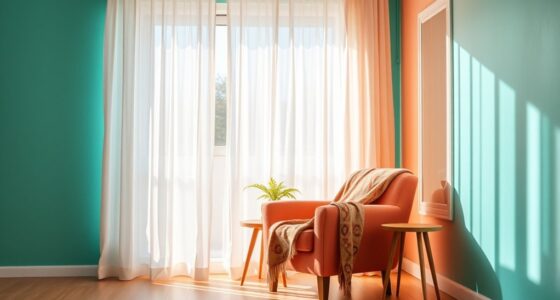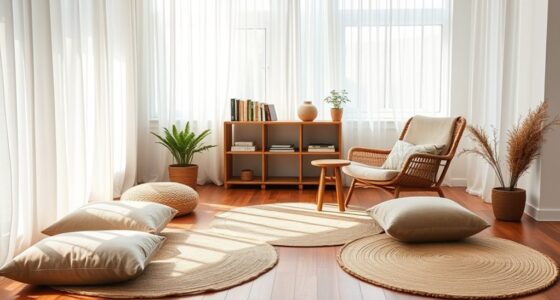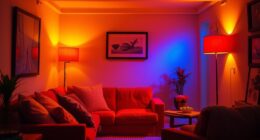A well-organized home can substantially boost your emotional health by reducing stress and feelings of overwhelm. Clutter increases sensory overload and signals a loss of control, which can lead to frustration and anxiety. Creating calm with tidy spaces, soothing lighting, and thoughtful color choices promotes relaxation and focus. Establishing routines helps maintain these positive effects over time. By choosing to prioritize organization, you’ll uncover how your environment supports emotional resilience and well-being—more insights await if you continue exploring.
Key Takeaways
- Organized spaces reduce visual chaos, lowering stress and promoting a sense of control and emotional stability.
- Clutter-free environments enhance mood, increase energy, and foster feelings of calm and positivity.
- Proper lighting and calming colors in organized spaces boost relaxation and mental clarity.
- Routine maintenance of organization supports mindfulness, reduces overwhelm, and sustains emotional well-being.
- A tidy home minimizes distractions, improves focus, and encourages productivity, contributing to overall mental health.
The Psychological Impact of Clutter and Disorder

Clutter and disorder can considerably affect your mental state, often leading to increased stress and feelings of being overwhelmed. When your space is cluttered, emotional clutter builds up, making it harder to focus and stay calm. Visual chaos creates sensory overload, forcing your brain to process too much at once. This constant stimulation can drain your energy and heighten anxiety levels. As clutter accumulates, you might find yourself feeling frustrated or hopeless, which only worsens your mental state. The disorder signals to your subconscious that things are out of control, undermining your sense of stability. Recognizing how clutter impacts your mind is the first step toward creating a more peaceful, healing environment where your mental health can flourish. Additionally, contrast ratio plays a role in how calming or stressful your visual environment feels, influencing your overall sense of well-being.
How Organization Reduces Stress and Anxiety

Have you ever noticed how a tidy space can immediately make you feel calmer? When you engage in mindful decluttering, you focus on intentionally removing what no longer serves you, which eases mental clutter. Sensory organization also plays a vital role; arranging items in a way that appeals to your senses creates a soothing environment. Clear surfaces, balanced colors, and organized storage reduce visual chaos, helping your mind relax. This intentional effort shifts your focus from stressors to a sense of control. As you streamline your surroundings, you lessen feelings of overwhelm and anxiety. Organization isn’t just about aesthetics—it’s a powerful tool to promote mental clarity and emotional stability, making your home a sanctuary that supports your well-being. Incorporating vertical storage solutions can further enhance your space, making organization more effective and accessible.
The Connection Between Clean Spaces and Mood Enhancement
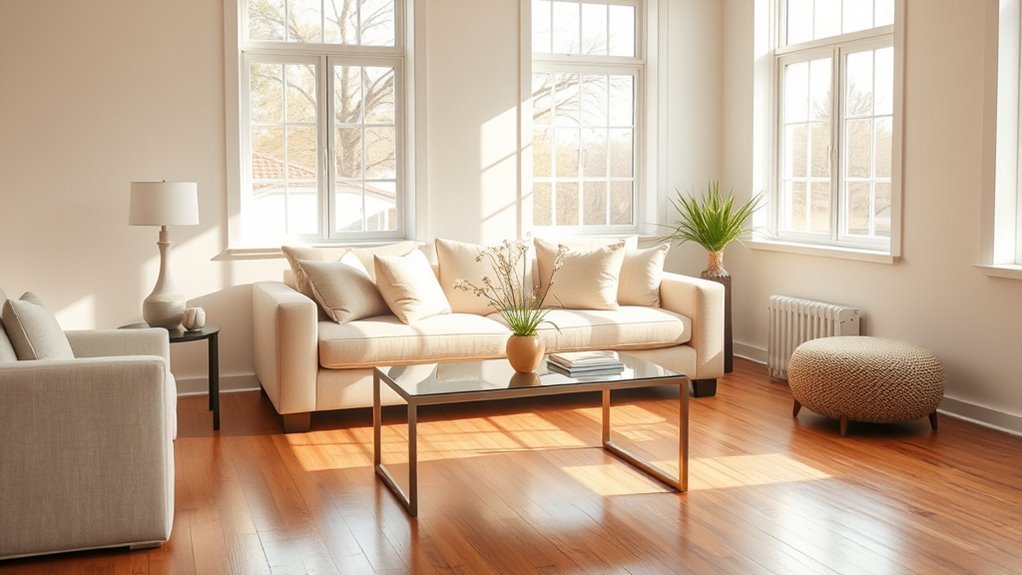
When your space is clean and organized, it’s easier to feel calm and focused. Bright, tidy rooms can lift your mood and make you feel more energized. Keeping areas orderly helps create a peaceful environment that supports your overall well-being. Additionally, an organized home can reduce stress by minimizing clutter-related distractions and promoting mindfulness in daily routines.
Clarity Reduces Stress
A tidy, organized space can considerably lessen your stress levels by creating a sense of calm and control. When your environment is clear, your mind feels less cluttered, making it easier to focus and relax. Incorporate mindful breathing exercises to anchor yourself in the present moment, reducing anxiety. Journaling techniques can also help you process your thoughts and gain perspective, further decreasing stress. When your space is free of chaos, it becomes easier to implement these practices, fostering mental clarity. This sense of order doesn’t just make your environment look better; it actively supports your emotional well-being. Clarity in your surroundings promotes a peaceful mindset, helping you navigate daily stresses with greater ease and resilience. Additionally, understanding the significance of dream symbols can deepen your self-awareness and emotional processing, further enhancing your overall mental health.
Bright Spaces Boost Mood
Bright, well-lit spaces can considerably elevate your mood by creating an inviting and energizing environment. Natural light plays a key role in this, as it triggers the release of serotonin, which boosts happiness and reduces feelings of depression. Additionally, color psychology shows that light, airy colors like soft yellows and blues can enhance positivity and calmness. When your space is filled with natural light, it not only makes your home look more appealing but also influences your emotional well-being. Bright spaces help you feel more alert, motivated, and optimistic each day. Incorporating crochet styles for locs and other creative decorating techniques can further personalize your environment and boost your mood. By maximizing natural light and choosing uplifting colors, you create an environment that naturally uplifts your mood and fosters a sense of well-being.
Organized Areas Promote Calm
Keeping your spaces organized can considerably reduce stress and create a sense of calm. When everything is in its place, your mind feels clearer, and anxiety diminishes. Incorporate decorative accents thoughtfully to enhance your space without cluttering it. Choosing calming color schemes like soft blues or neutral tones can further promote relaxation. An organized area allows your surroundings to breathe, making it easier to unwind. Consider these tips:
- Use decorative accents to add personality without chaos
- Stick to a cohesive color scheme for a soothing environment
- Keep surfaces clear of unnecessary items
- Designate specific spots for essentials to avoid clutter
- Maintaining organized spaces can also improve your personal finance management, reducing the mental load associated with financial clutter.
Improved Focus and Productivity Through Home Organization
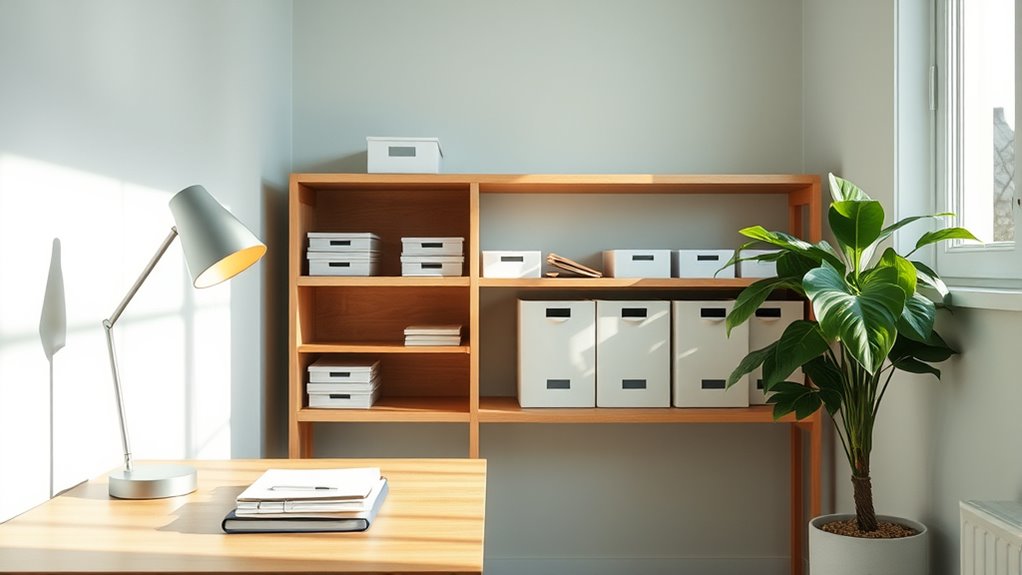
When your home is well-organized, it becomes easier to stay focused and boost your productivity. A tidy home office minimizes distractions, allowing you to concentrate on tasks without searching for essentials or feeling overwhelmed. Clear spaces support your personal routines, making it simpler to start your day with intention. When everything has a designated place, you spend less time managing clutter and more time working efficiently. An organized environment also helps you establish consistent habits, reinforcing a sense of control and motivation. As a result, you’re more likely to meet deadlines, complete projects, and feel accomplished. Simplifying your space directly impacts your mental clarity, empowering you to work smarter and stay on top of your goals effortlessly. Incorporating elements from a well-designed bedroom can further enhance your ability to relax and recharge, positively influencing your overall productivity.
The Science Behind Spatial Arrangement and Mental Clarity
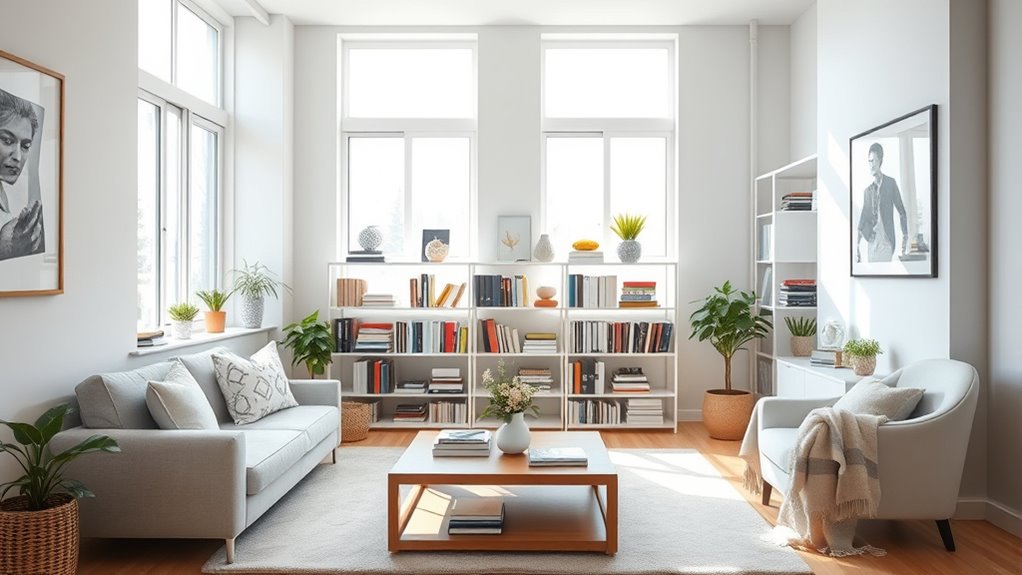
Research shows that the way you arrange your space directly influences your mental clarity by affecting how your brain processes information. Your spatial perception, shaped by environmental psychology, plays a key role in how organized surroundings impact your focus. When clutter disrupts your environment, your brain struggles to filter out unnecessary stimuli, leading to mental fatigue. Conversely, a well-organized space promotes calmness and enhances cognitive function. By understanding how spatial arrangement affects your mind, you can create environments that foster clarity and reduce stress. Additionally, incorporating cultural and regional breakfast concepts can inspire personalized organization strategies that make your space feel more familiar and comforting.
Practical Strategies for Creating a Calming Environment
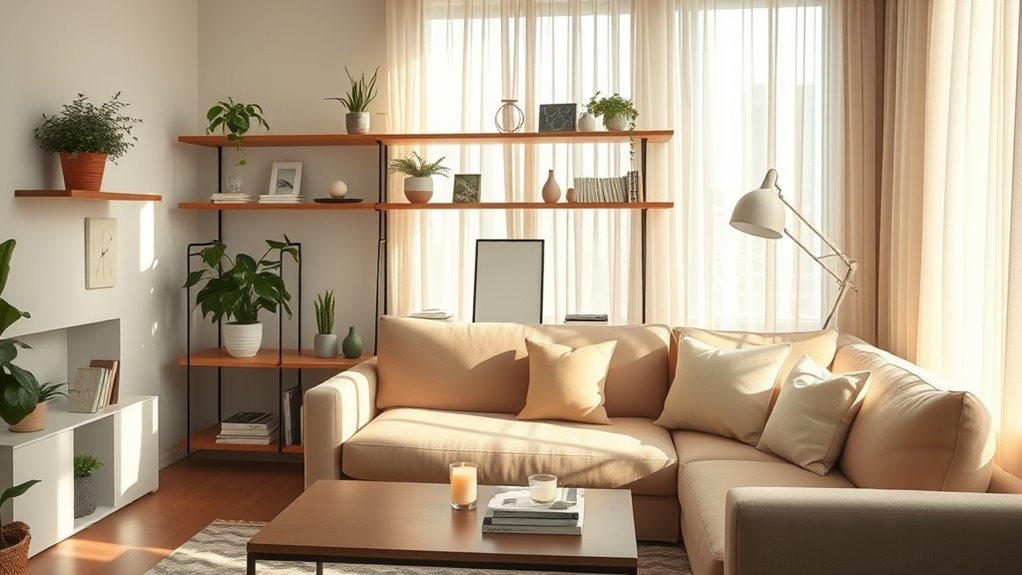
Creating a calming environment starts with intentional organization and mindful choices in your space. Use decorative accents, like soft textiles or simple artwork, to add warmth without clutter. Incorporate elements that align with color psychology; soothing hues such as blues, greens, or pastel shades promote relaxation and reduce stress. Keep surfaces clear and organized to foster a sense of order and tranquility. Limit visual clutter by choosing a few meaningful decorative accents rather than overwhelming the space. Lighting also plays a key role—opt for soft, warm lighting to create a cozy atmosphere. With mindful placement and color choices, your environment becomes a sanctuary that supports mental clarity and emotional well-being. Small, intentional updates can markedly influence your overall sense of calm. Employing effective composition techniques can also help in arranging your space to enhance its calming effect.
The Role of Routine and Maintenance in Sustaining Well-Being
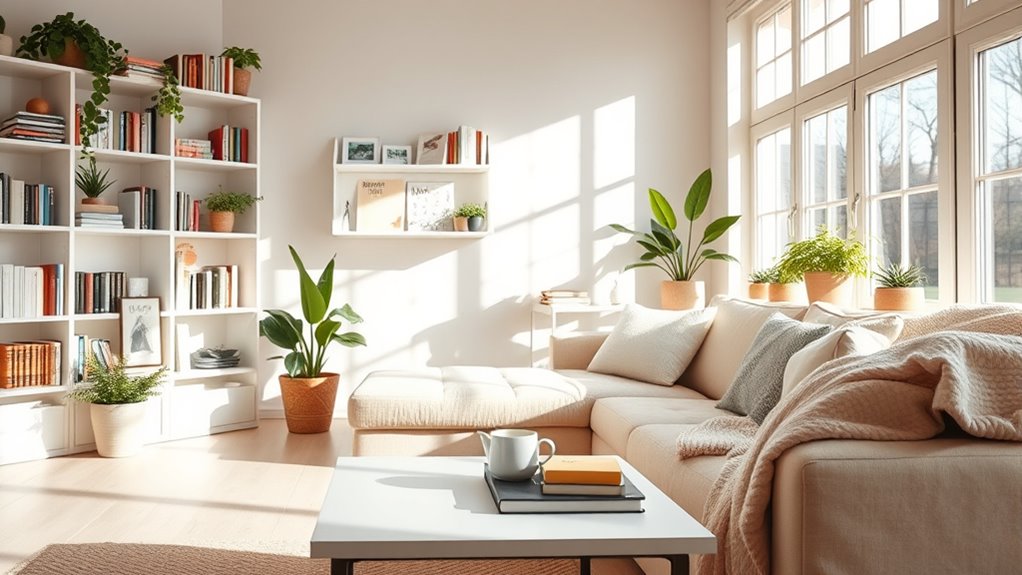
Establishing a consistent routine and maintaining regular upkeep are essential for sustaining the sense of calm and balance you’ve worked to create in your home. Daily rituals, like tidying up each evening or starting your day with a quick cleaning routine, keep your space organized and reduce stress. Consistency helps prevent clutter from piling up and reinforces positive habits that support your well-being. When you stick to these routines, you create a predictable environment that promotes relaxation and focus. Small, intentional actions daily can make a big difference in maintaining harmony. Incorporating grocery savings strategies into your routine can also help manage household expenses more effectively.
Transforming Your Space to Support Emotional Resilience
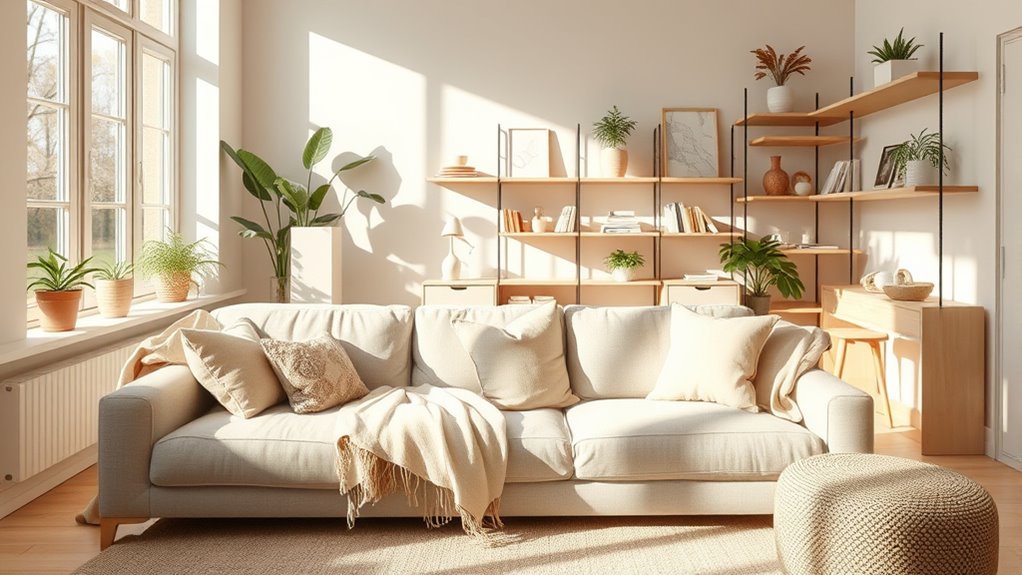
To truly support your emotional resilience, you need to intentionally design your space to nurture positive feelings and promote a sense of safety. Incorporate decorative storage solutions to keep clutter out of sight, creating a calm environment that reduces stress. Use color psychology to select hues that foster tranquility and optimism—soft blues and greens can soothe, while warm yellows boost mood. Arrange your furniture to encourage openness and natural light, enhancing feelings of safety and comfort. Personalize your space with meaningful objects that inspire joy and resilience. By consciously transforming your environment, you create a sanctuary that supports emotional well-being, helping you face challenges with greater strength and balance.
Frequently Asked Questions
How Quickly Can Home Organization Improve Mental Health?
You might notice improvements in your mental health quite quickly after organizing your home. As you declutter and create order, your stress levels decrease and emotional resilience strengthens. This process can bring immediate relief, helping you feel more in control and calmer. While long-term benefits grow with consistency, even initial steps toward organization can boost your mood and reduce anxiety, making a more peaceful environment a swift pathway to mental well-being.
Are There Specific Colors That Enhance a Calming Environment?
You might wonder if certain colors can create a calming environment. According to color psychology, mood-enhancing hues like soft blues, gentle greens, and neutral tones promote relaxation and reduce stress. These colors are known to soothe the mind and help you feel more peaceful in your space. Incorporating these hues into your home can foster a serene atmosphere, making it easier to unwind and enjoy a calming environment every day.
Can Decluttering Actually Prevent Future Stress Episodes?
It’s no coincidence that decluttering can prevent future stress episodes. When you reduce clutter, you lower feelings of anxiety and create a calmer environment. Developing organizational habits helps you stay on top of your space, making it easier to manage daily stressors. By maintaining a tidy home, you foster a sense of control, which can considerably decrease the likelihood of future anxiety triggered by chaotic surroundings.
What Role Does Lighting Play in a Home’S Psychological Impact?
Lighting plays a vital role in shaping your home’s psychological impact. You should focus on creating a positive lighting ambiance by combining natural light with well-placed artificial lighting. Natural light boosts your mood and energy, making your space feel more inviting. Using warm, soft light in the evenings can promote relaxation. Proper lighting not only enhances aesthetics but also supports your mental well-being, helping you feel more comfortable and balanced at home.
How Do Personal Preferences Influence Effective Home Organization Strategies?
Your personal preferences greatly influence effective home organization strategies. By understanding your personal taste and organizational style, you can create a space that feels comfortable and motivating. Focus on what works best for you, whether it’s minimalism or a more eclectic approach. When your environment aligns with your preferences, you’re more likely to maintain it, making your home a true reflection of your personality and a source of comfort.
Conclusion
When you organize your home, you’re not just tidying up—you’re nurturing your mental health. A clutter-free space reduces stress, boosts mood, and sharpens focus, creating a calming environment that supports emotional resilience. By establishing routines and maintaining order, you reinforce these benefits over time. Remember, your surroundings influence your well-being more than you might realize. Embrace the power of organization, and watch your mental clarity and happiness flourish.



